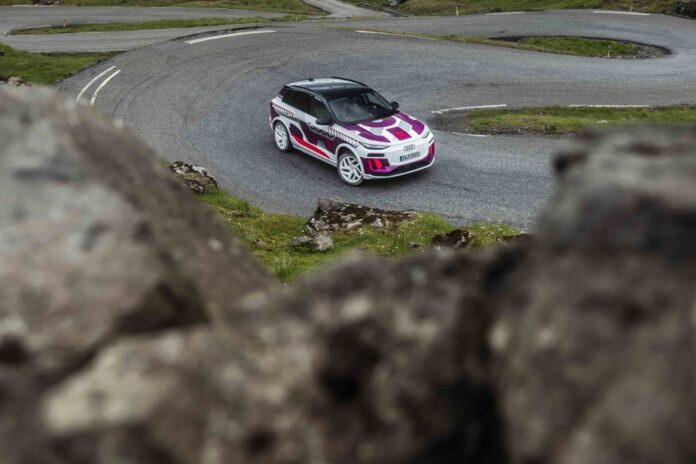Participating, before the start of production, in one of the development and validation sessions of a future model is not something you can refuse. Even if several of its characteristics are still classified, the Q6 e-Tron makes no secret of the challenges posed by its new architecture and the rivals it intends to face.
The Faroe Islands – an archipelago of 52,889 inhabitants and some 100,000 sheep – saw a procession of Q6 e-Trons in camouflage gear parade on their roads last summer. This fully electric SUV that Audi will market starting next year inaugurates a brand new modular architecture called PPE (Premium Platform Electric).
Co-developed by Audi and Porsche, this platform will ultimately benefit not only its designers, but also the entire luxury division of the Volkswagen group (Bentley, Lamborghini). All these beautiful people will be able to lengthen, shorten and style this architecture with the bodywork of their choice. According to data obtained from the VW group, this architecture makes it possible to vary the wheelbase from 2890 to 3080 millimeters and the ground clearance from 152 to 217 millimeters. The tracks (front and rear) are also extendable.
The PPE platform will make the most of the advantages of electrification (interior space, center of gravity), but will also take care to minimize the weaknesses inherent to this type of propellant (mainly weight). And just like the e-Tron GT and RS, this upcoming Q6 will adopt batteries with a voltage of 800 V to reduce charging time. Their capacity should be somewhere between 90 and 100 kWh. Audi has still not made this information official. No more than the electric range of this model which, according to initial estimates, could oscillate between 480 and 523 km.
The engines will also be taken from the e-Tron GT and RS, but optimized in their architecture. Everything indicates, in North America at least, that only the Quattro (four-wheel drive) transmission mode will be offered. Europe will be entitled to a version driving only the rear wheels. More energy efficient, the latter would also benefit from a more advantageous weight distribution than that of the Quattro (52:48 compared to 50:50 for the two-wheel drive). Two other versions (S and RS) appear in the specifications for this model. Of the two, it’s the RS that’s likely to be more striking with a power output of nearly 600 horsepower and some 700 lb-ft of torque. In its base configuration, the Q6 e-Tron will produce the equivalent of 376 horsepower, while the S will have 110 more.
These last two advances aim to make this Audi more agile to drive while creating the impression of being behind the wheel of a lighter vehicle than it really is. In this regard, Audi is refraining from communicating the weight of this new model for the moment.
The Q6 e-Tron has exterior dimensions roughly equivalent to those of the Q5, but interior space that would put the massive Q7 to shame. Keen to cast as wide a net as possible, the brand with the rings will double its Q6 e-Tron range with a Sportback version. Even more streamlined due to the curve of its roof, it promises to be more efficient (a reduced aerodynamic coefficient increases autonomy) if not as functional. The differences will be particularly noticeable in terms of headroom (front and rear), but also in trunk volume, which is around 10% lower.
During these sessions on the deserted roads of the archipelago, there were many restrictions. Impossible to overtake, even less to carry out acceleration or recovery measures. The convoy was moving at a good pace, however, and this made it possible to check certain dynamic elements of the vehicle, starting with the suspension. This, electronically controlled, displays exquisite flexibility and maintains the trim in perfect balance, even in abruptly negotiated turns. However, the management appeared to us to be too overassisted. Disconnected, it proves incapable of imprinting the relief of the road in our hands. The standard Q6 e-Tron will offer configuration using its Audi Select software, but it remains to be seen whether it will gain in firmness and responsiveness. On the other hand, the braking proved to be the nice surprise of this test. Easy to modulate, efficient and sturdy.
At the time of this first contact, Audi had carefully masked the dashboard. The shapes and characteristics of this would be revealed a few weeks later during the Munich Mobility Show. It was also during this first time in the public eye that the body of the Q6 e-Tron got rid of the garish (or trendy, depending) colored stripes that covered it.
Even if we regret that several of them fit into the central screen, the controls are orderly and easy to identify. On the other hand, we will be surprised to find, in the armrest of the door, those which activate the headlights. Since we’re on the subject, let’s point out that the Q6 e-Tron intends to innovate by using headlights and lights as passive safety devices. Thus, the light strip will offer a function allowing it to scroll through pictograms similar to those on road signs for other motorists. An advance that the German brand wishes to approve, including in North America where legislators have until now demonstrated dusty conformism with regard to lighting.
Starting at $80,000 (estimate)
None
Between 480 km and 523 km
In a few months, we will see more clearly.
La Presse will soon publish the test of the following vehicles: Cadillac Lyriq, GMC Sierra, Lucid Air, Porsche Cayenne, Subaru Crosstrek, Toyota Tacoma. If you own or are awaiting delivery of one of these vehicles, we would love to hear from you.















